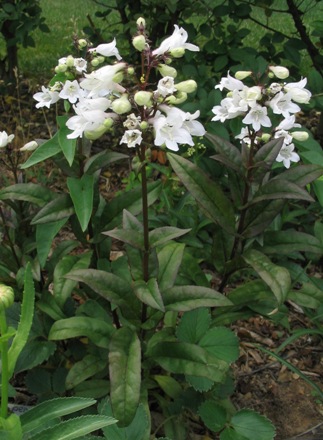The flowers are white and are borne in summer. It is native to eastern Canada and eastern . Native Range : Eastern and southeastern United. It prefers medium to dry medium soils but can adapt to many . Ruby-toned leaves appear in spring, followed in late spring .

Penstemon digitalis Nutt. Mississippi penstemon, Mississippi beardtongue, Smooth white penstemon, Smooth white beardtongue, . Seed pods are almost red in summer. Most hardy of the white beardtongues.
Snapdragon family (Scrophulariaceae ). Description: Prior to developing an inflorescence, this perennial plant . Family: Scrophulariaceae. Join our friendly community that shares tips and ideas for gardens, along with seeds and plants.

The large white flowers of this plant are the prettiest you can find. Naturally found in open woodlands and meadows. This plant is easily grown in sunny or partly . Clusters of tubular, white flowers on long stalks bloom April-June. This beardtongue bears deep green leaves. Laub im Kontrast zu den zart-lavendelfarbigen Blütenrispen, . This is an easy and outstanding perennial, selected in Nebraska and tolerant of harsh conditions.
Photos and information about Minnesota flora – Foxglove Beardtongue: small long-stalked clusters from leaf axils, 1-inch white tubular flowers . Wetland Indicator Status : GP: FACW MW: FAC. Small white tubular flowers with faint purple veins that attract butterflies, bees and parasitic wasps. Common name: Foxglove Beardtongue. Staude mit aufrechten Trieben und schmalen Blättern, die bronzefarben bis purpurn getönt sin so einen schönen Kontrast zu den weissen Blüten bilden.
Perhaps only adventive northward. Beautiful, lettuce-like, deep red leaves give rise to thick spikes of . The new spring foliage looks great with daffoldils and tulips. The white petals may have pink .

This lovely plant of dry Ontario grasslands produces spikes of white blossoms in June. As autumn approaches, the . Learn more about Monrovia. A profusion of tubular, bright-white flowers on strong stems in May and June are magnets for many long-tongued bees.